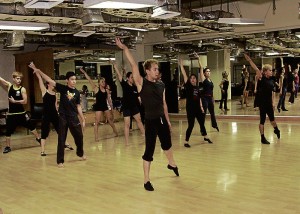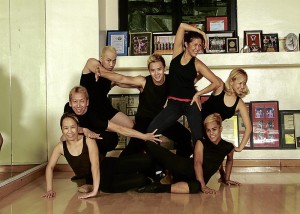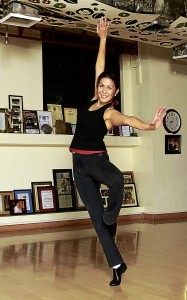
While studying in America, TV personality Maria Cristina “Chiqui” Roa Puno was dubbed “a boy with a skirt” as she easily took to football, softball and basketball.
Today, her energy for sports has been channeled to jazz dancing, a style of sensual and percussive movements, popularized by musicals and Hollywood shows. The noncompetitive environment, discipline, total body workout and expressive quality of jazz appeal to Puno.
“When I came back from the States, I was on the lookout for dance groups. I enjoyed show dance and took up jazz classes,” she recalls. After watching a performance of Douglas Nierras Powerdance (DNPD), she sought them out.
For over a decade, Puno has been diligently taking classes despite her hectic schedule. At 42, she easily blends in with dancers half her age. She flings her neck, fanny, torso, shoulders, angled arms and legs with nonchalant abandon which she brings to her dancing.
How does she balance work, family and art?
“For working people, it’s a matter of deciding the priority. I have to pencil in my workouts into my schedule,” replies Puno. “The only things that have kept me out of the studio were work, pregnancy and injuries.”

Get sexy
With over 15 years of experience in broadcasting, she is the senior sports correspondent of “News 5.” She has covered the Manny Pacquiao fights, the Philippine Basketball Association, the Southeast Asian Games and the Asian Games. “Lately, I’ve been doing mommy shows.”
She wakes up at 3:30 a.m. to gird for “Good Morning Club” on TV 5, which starts at 5:30 a.m. The show allows her to cover a variety of subjects, such as parenting and wellness, and even allowed her to try flamenco, aerial yoga and Bikram yoga in front of the camera.
To show off her terpsichorean skills, the program offers a five-minute segment, “Chiqui Chiqui Dance,” which teaches a short and easy dance routine for people with two left feet.
The tagline “Di na kailangan gumastos para sumeksi dahil Chiqui Dance lang ang remedy (No need to spend to get a great figure. Chiqui Dance is the remedy)” has made it a much-awaited segment.

“My Powerdance training came in handy for this,” she says. “Jazz makes you agile. Spiritually, it allows you to express yourself more. It’s not as rigid as ballet, and it takes more discipline than hip-hop.”
Off the dance floor, Puno juggles her career as a congressional spouse to Roberto Puno, representative of the third district of Rizal, and mother to three children—Randy, 19, a freshman at Georgetown University in Washington, D.C.; Nick, 17, a senior in Ateneo high school; and Sabrina, 6, a kindergarten student in Poveda.
Puno was still dancing until her seventh month of pregnancy with her youngest. Being fit with jazz, her pregnancy was easy, as was her recovery after the delivery.
Although she dabbles in body combat, taebo and Muay Thai, Puno reverts to jazz, which has given her a solid foundation. She believes that in dance, freedom of movement is achieved through control, commitment and following the rules. “To do the things you want to do, you’ve got to know the rules before you break them. That’s what hip-hop’s freestyle is all about. It would have been harder for me if I started with hip-hop before jazz.”
Boosting self-esteem
DNPD’s associate artistic director Danilo Marshall lauds Puno for her passion and consistency. As a result of her efforts, her dancing exudes refinement and expressiveness. When she started, her dancing was too soft and lifeless. Now she attacks the movements with the right dynamics.
“As we mature, every experience in our lives adds something to the dance. You don’t get that texture from younger dancers,” he explains. “Physically, she’s stronger. Jumping was her weakness. I used to yell at her all the time, ‘Jump!’ She could jump only a foot from the floor. Now she hits the roof with the correct feel.”
With the reign of hip-hop and street dance, why take up jazz?
Marshall explains that jazz builds self-esteem, and one develops the understanding of the structure of the art. DNPD’s method follows a syllabus, which allows students to learn the vocabulary of jazz in progressive levels.
“The path to looking beautiful is discipline. There’s no other way,” he maintains. The student develops the correct skills more quickly under an uncompromising teacher.
Aside from fun and exercise, jazz develops the mind. Students learn to count rhythms and improve their reflexes. “It puts you on a different plane of awareness. You don’t get that in an aerobics class, with mindless repetitions of movements. In jazz, you have to make a decision every minute,” says Marshall.
Beyond technique, jazz inspires you to see what’s inside your soul and let it all out. This is why students keep coming back to take up jazz.
“In the past, many students enrolled for fitness reasons,” he says. “Now, many come back for the love of dance. They were putting it off before. Now that they have the time, they take it up for their self-expression.”
For 90 minutes, the students are insulated from either boredom or pressures of the outside world. They immerse themselves in an atmosphere of high energy and concentration.
“It’s the moment when you get a chance to be in control,” says Marshall. “You may not have done everything correctly, but knowing that you did one step beautifully brings satisfaction. That lifts up your self-esteem. It reaffirms who you are, and strengthens your belief in what you’re capable of.”
Douglas Nierras Powerdance offers jazz and hip-hop at Savannah Moon Studio, Libis, Quezon City. Contact 0915-8552790 or 0915-5015342.

